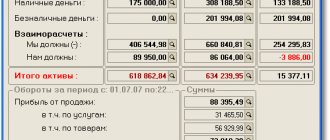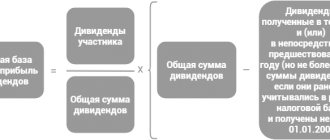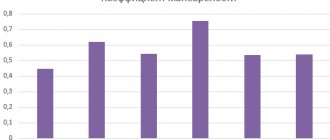Factor analysis of sales profit
Factor analysis is a method of complex and systematic measurement and study of the influence of factors on the size of the final indicators. It is carried out on the basis of accounting. report on the second form.
The main purpose of such an analysis is to find ways to increase the profitability of the company.
The main factors that influence profit margins are:
- Product sales volume . To find out how it affects profitability, you need to multiply the change in the number of goods sold by the profit of the previous reporting period.
- Variety of products sold . To find out its impact, you need to compare the profit of the current period, which is calculated based on the cost and prices of the base period, with the base profit, recalculated for the change in the number of products sold.
- Change in cost . To find out its impact, you need to compare the cost of sales of goods in the reporting period with the costs of the base period, which are recalculated for changes in the level of sales.
- Commercial and administrative costs . Their impact is calculated by comparing their sizes in the base period and the reporting period.
- Price level. To find out its impact, you need to compare the sales level of the reporting period and the base period.
Research of factors that can affect financial results
The task of studying financial results is to monitor the implementation of plans and determine what objective and subjective factors influence the level of income. The calculation process uses accounting data and information from the business plan. Based on the results, reserves are determined to increase net income.
Calculations are carried out according to:
- gross, taxable, net profit
- income from the sale of basic goods (services, works)
- income from other sales
- non-operating income
Research objectives:
- determine deviations for each characteristic
- explore the change and structure of each indicator
- evaluate profitability
- evaluate the performance of an enterprise for a certain period
The structure and composition of income, dynamics in comparison with previous time periods, the impact of the chosen accounting policy on each type of profit and the amount of deductions for dividends and taxes are analyzed.
It is important to take into account all the factors affecting the result of business activity:
- income from transactions with currencies, deposits, bonds, shares
- losses from bad debts, penalties, fines, penalties
- rental income, received penalties, fines, penalties
- losses from negative profits of previous periods and natural disasters
- costs of paying taxes and contributions to extra-budgetary funds
The main indicator of successful work is high profitability. A study of the dependence of this indicator for the entire enterprise and for each area of activity is required. The profitability of sales, return on invested capital, investments and costs are assessed. Calculations are carried out for each type of profit (gross, sales, net).
Factor analysis consists of several stages:
- selection of factors
- their systematization and classification
- modeling relationships between a factor and a result
- determination of each factor and calculation of its influence on the result of economic activity
- developing recommendations that allow the results to be used in practice
Key elements: changes in profitability, income and expenses.
For factorial research, you can use other indicators, for example profitability:
- investments (ratio of the amount in the “bottom line” to the amount of own funds)
- equity
- assets (the ratio of the amount in the “bottom line” to the total volume of the first section of the balance sheet)
- working capital (ratio of the amount in the “bottom line” to the volume of working capital)
- sales (ratio of the amount in the “bottom line” to revenue)
The difference between the amounts for the base and current year is calculated, and the factors that influenced the changes are identified.
Factor analysis of sales profit - calculation example
Background information:
| Index | Base period, thousand rubles. | Report period | Absolute change | Relative change, % |
| Revenue amount | 57700 | 54200 | -3500 | -6,2 |
| Product cost | 41800 | 39800 | -2000 | -4,9 |
| Business expenses | 2600 | 1400 | -1200 | -43,6 |
| Administrative costs | 4800 | 3700 | -1100 | -21,8 |
| Profit | 8500 | 9100 | 600 | 7,4 |
| Price changes | 1,05 | 1,15 | 0,10 | 15 |
| Volume of sales | 57800 | 47100 | -10700 | -18,5 |
The factors listed above had the following impact on profit:
- Volume of products sold – -1578 thousand rubles.
- Variety of goods sold – -1373 thousand rubles.
- Cost – -5679 thousand rubles.
- Commercial costs – +1140 thousand rubles.
- Administrative costs – +1051 thousand rubles.
- Prices – +7068 thousand rubles.
- Influence of all factors – +630 thousand rubles.
Factor analysis of net profit - calculation example
Initial information for analysis:
| Index | Size, thousand rubles | ||
| Base period | Real volume expressed in basic prices | Report period | |
| Revenue | 43000 | 32000 | 41000 |
| Cost price | 31000 | 22000 | 32000 |
| Selling expenses | 5600 | 4700 | 6300 |
| Management costs | 1100 | 750 | 940 |
| Full cost | 37600 | 27350 | 39200 |
| Profit Loss) | 5000 | 4650 | 2000 |
Let's analyze:
- Profit decreased by 3,000 thousand rubles.
- The sales level fell by 25.58%, which amounted to 1,394 thousand rubles.
- The impact of changes in the price level amounted to 9,000 thousand rubles.
- Impact of cost - 11850 thousand rubles.
Factor analysis of gross profit - example
Initial information is given in the table:
| Index | Base period | Report period | Deviation | |
| At base prices | At market prices | |||
| Sales revenue | 70600 | 79100 | 102000 | 31400 |
| Cost price | 56550 | 62200 | 79400 | 22850 |
| Gross profit | 14000 | 16800 | 22600 | 8600 |
Substituting the initial data into the formula, we find that the impact of changes in revenue amounted to 1,686 thousand rubles.
Analysis of the organization's financial results
Characteristics of the organization's financial results
The financial results of an organization are reflected by a number of indicators, each of which has its own significance in the analysis.
Income of the organization
An organization's income is recognized as an increase in economic benefits as a result of the receipt of assets (cash, other property) or the repayment of liabilities, leading to an increase in the organization's capital, with the exception of contributions from participants (own property).
Income does not include receipts from other legal entities and citizens:
- amounts of value added tax, excise taxes, export duties and other mandatory similar payments;
- under commission agreements, agency and other similar agreements in favor of the principal, principal, etc.;
- in advance payment for products, goods, works and services;
- advances to pay for the production of goods, works and services;
- as collateral, if the agreement provides for the transfer of the pledged property to the pledgee;
- in repayment of a loan granted to the borrower.
Depending on the type of activity and the conditions for receipt, the organization’s income is classified into income from ordinary activities (regular, systematic) and other income (irregular, unsystematic).
Table 5.1. Classification of an organization's income depending on the type of activity
| Income from ordinary activities | Other supply |
| 1. Revenue from the sale of products and goods, receipts related to the performance of work, provision of services (finished products and semi-finished products of own production; from works and services of an industrial and non-industrial nature, purchased products purchased for completion; from construction, installation and similar works ; services for the transportation of goods, passengers, communication services, etc.) | 1. Operating income (receipts related to the provision for temporary use of the organization’s assets for a fee; receipts related to the provision for a fee of rights arising from patents for inventions, industrial designs and other types of intellectual property; receipts related to participation in the authorized capital of other organizations (including interest and other income on securities); profit received by an organization as a result of joint activities (under a simple partnership agreement); proceeds from the sale of fixed assets and other assets other than cash (except foreign currency), products, goods; interest received for the provision of an organization’s funds for use; as well as interest for the bank’s use of funds held in the organization’s account with this bank) |
| 2. Revenue from other types of activities related to the main ones (provision for a fee for the temporary use of one’s assets under a lease agreement; provision for a fee of rights arising from patents for inventions, industrial designs and other types of intellectual property; participation in the authorized capital of other organizations) | 2. Non-operating income (fines, penalties, penalties for violation of the terms of contracts; assets received free of charge, including under a gift agreement; proceeds to compensate for losses caused to the organization; profit of previous years identified in the reporting year; amounts of accounts payable and depository, according to for which the statute of limitations has expired; exchange rate differences; amounts before valuation of assets (except for non-current assets); other non-operating income) |
| 3. Extraordinary income (includes income arising as a consequence of emergency circumstances of economic activity: insurance compensation, the cost of material assets remaining from the write-off of assets unsuitable for restoration and further use, etc.) |
An organization's total income is the sum of income from ordinary activities, operating and non-operating income, and extraordinary income.
Organization expenses
- these are all costs that, in a given period of time in the course of business activities, lead to a change (reduction or other expenditure) of the organization’s assets and serve to generate corresponding income.
Main types of expenses of the organization:
- expenses for ordinary activities - expenses associated with the manufacture and sale of products, acquisition and sale of goods; with the performance of work, provision of services and other normal activities. They also include reimbursement of the cost of fixed assets, intangible assets and other depreciable assets, carried out in the form of depreciation charges;
- operating expenses of an organization are expenses associated with: provision for a fee for temporary use of: assets of the organization; rights arising from patents for inventions, industrial designs and other types of intellectual property; with participation in the authorized capitals of other organizations; with the sale, disposal and other write-off of fixed assets and other assets other than cash (except for foreign currency); goods, products; interest paid by an organization for providing it with funds (credits, borrowings) for use; payment for services provided by credit institutions; other operating expenses. The amount of operating expenses reflects a significant part of the financial costs associated with the payment of interest on the loan. Operating expenses reduce profits from product sales, their growth can lead to unprofitable activities in general;
- non-operating expenses are expenses: associated with fines, penalties, penalties for violation of contract terms; with compensation for losses caused by the organization; losses of previous years recognized in the reporting year; amounts of receivables for which the statute of limitations has expired, and other debts that are unrealistic for collection; exchange differences; the amount of depreciation of assets (except for non-current assets);
- deferred expenses (deferred expenses) - expenses incurred in the reporting period, but not recognized as expenses of this period. Expenses are considered as assets of the organization (for example, the amounts of rent or insurance payments paid in advance for several periods (months, years) are subject to inclusion in the costs of production in subsequent periods evenly). These include costs for the development of new types of products, improvement of production technology, mining preparatory and stripping work, etc. They are written off to the cost of production in future periods as they are developed.
Costs in relation to the cost of production are divided into direct and indirect.
Direct expenses
These are direct material costs and direct labor costs.
Direct material costs
- costs associated with the production of certain types of products, which can be directly and directly included in the cost of production. These are the costs of raw materials, basic materials, purchased semi-finished products and components, etc. Material costs that cannot be directly attributed to a specific type of product are indirect material costs. Each organization, based on the specifics of the production process, independently decides which materials are classified as primary and which as auxiliary.
Direct labor costs
— labor costs that can be directly attributed to a specific type of finished product. These include the wages of workers directly involved in the production of products (equipment operator). If labor costs cannot be attributed directly to a specific type of product, then they are indirect labor resources (wages for support staff, managers, foreman, etc.).
Indirect costs
— costs that are economically unprofitable to take into account or cannot be attributed directly to specific types of products are usually called indirect, or overhead. They are divided into two groups: general production (production) and general business (non-production) expenses.
General production expenses
— arise in production units: sections, workshops, production areas, processing areas. They are closely related directly to production. These include general workshop costs for organization, maintenance and production management.
General production expenses are divided into the following groups: expenses for maintenance and operation of equipment; general shop management costs.
General running costs
- these are expenses not directly related to the production process, but only to general maintenance and organization of production and management of the organization as a whole. The main groups of general business expenses: administrative and management expenses for managing supply, procurement, sales, and financial activities; maintenance of general business personnel; depreciation charges and expenses for repairs of fixed assets of management and general business personnel; rent for general business premises; payment for services provided by external organizations (information, auditing, consulting and other services); expenses for personnel training (recruitment, selection, training, retraining); expenses for managing supply, procurement, and sales activities; financial activities; mandatory fees, taxes, payments and deductions in accordance with the procedure established by law.
Organizational profit
Profit
- this is part of the net income created in the production process and realized in the sphere of circulation. She:
- characterizes the financial result of entrepreneurial activity;
- is the basis for the economic development of the organization;
- most fully reflects production efficiency, the volume and quality of products produced, the state of labor productivity, and the level of cost.
Profit has a stimulating effect on strengthening commercial calculations and intensifying production under any form of ownership. Profit growth creates a financial basis for self-financing, expanded reproduction, solving social problems, and meeting the material needs of work collectives. At the expense of profits, the organization’s obligations to the budget, banks and other organizations are fulfilled. Profit indicators characterize the degree of business activity and financial well-being. Profit determines the level of return on advanced funds and the return on investment in assets.
The economic activities of the organization are quite diverse, these include production, supply, sales and commercial activities. Therefore, the profit of an organization takes different forms. The starting point in calculating profit indicators is revenue from sales of products, goods and services, which characterizes the completion of the organization’s production cycle, the return of funds advanced for production and their conversion into cash, as well as the beginning of a new cycle in the turnover of all funds. Changes in sales volume have the most sensitive impact on the financial performance of an organization.
Types of profit
- Gross profit
(GPR) is the difference between sales revenue and cost of goods sold (C) for the same period:
VPR = B - C.
The size of the VPR is used to characterize the efficiency of the organization’s production divisions.
- Profit from sales of products
(PS) - the difference between gross profit and period expenses for core activities (PR) for the same period:
PRP = VPR - RPR, or PRP = B - C - RPR.
Subtracting periodic expenses from gross profit, in accordance with international accounting standards, helps to share the entrepreneur's risk from possible non-sale of products with the state. The amount of profit from sales is used to assess the effectiveness of core activities.
- Profit from financial and economic activities
(PRFH) - the sum of profit from sales and the overall result from financial transactions (interest receivable and payable, income from participation in other organizations, etc.):
PRFH = PRP + RFD.
The value of the PFH is used to assess the effectiveness of the core and financial activities of the organization.
- Profit before tax (balance sheet profit)
(BPR) is the sum of profit from financial and economic activities (PRFH) and profit (expense) from other non-operating operations (RVN):
BPR = PRFH + RVN.
Balance sheet profit is an indicator of the economic efficiency of all economic activities of an enterprise.
- Net profit (loss) of the reporting period
(NPR):
ChPR = BPR - TNAL,
Where
BPR - balance sheet profit;
TNAL - current income tax.
Current income tax (current tax loss) is an income tax for tax purposes, determined based on the amount of conditional expense (conditional income), adjusted to the amount of permanent tax liability, deferred tax asset and deferred tax liability of the reporting period.
- Deferred tax liabilities are that part of deferred income tax that should lead to an increase in income tax payable to the budget in the next reporting period or in subsequent reporting periods.
- Deferred tax assets are that part of deferred income tax that should lead to a reduction in income tax payable to the budget in the next reporting period or in subsequent reporting periods.
For tax purposes, book profits are adjusted in accordance with tax standards, i.e. in accordance with the Regulations on the composition of costs included in the cost of production. From the point of view of the organization, tax, as a system of gratuitous withdrawal of a certain share of profit to the state budget, is an inevitable, objectively necessary element in the process of functioning of the organization’s capital. The amount of taxes can be minimized by improving the system of internal production planning and control of costs and investments, through comprehensive rationalization of business activities and a reasonable choice of accounting policies.
The concept of net profit in Russia does not correspond to the concept of net profit by international standards. Net profit in Russia includes significant expenses (consumption funds, social funds, etc.), which is unacceptable by Western standards. The amount of retained earnings reflects the final financial result of the organization for the reporting period, including all types of expenses and income.
The net profit of the reporting year (NPR) is recorded in the balance sheet of the reporting year as retained earnings, and the result of the distribution of this profit by shareholders is reflected in the balance sheet of the following year. The remaining undistributed profit of the reporting year characterizes, as it were, an accumulation fund, since it mainly goes to the development of the enterprise, increasing its own capital.
The balance sheet profit of an organization is subject to distribution, which means its direction to the budget of the state or organization in accordance with existing legislation. In accordance with it, the legislative distribution of profits is regulated in the part that goes to budgets of different levels in the form of taxes and other obligatory payments. Determining the directions for spending the profit remaining at the disposal of the organization, the structure of the items of its use is within the competence of the organization’s management.
When distributing profits, the principles of forming a profit distribution system are taken into account:
- the distribution and use of profits in market conditions is an important economic process that must cover the needs of the enterprise for normal functioning;
- the profit distribution mechanism should help improve production efficiency, stimulate more progressive forms of management, determine the rational ratio of the share of profit accumulated in budget revenues and remaining at the disposal of the enterprise;
- the profit distribution system must economically justify guarantees of fulfillment of financial obligations to the state, contribute to the rational provision of the enterprise’s production process with resources at the lowest cost;
- the profit received by the enterprise as a result of production, economic and financial activities is distributed between the state and the enterprise as an economic entity;
- profit for the state goes to budgets in the form of taxes and fees; the composition, rates of taxes, the procedure for their calculation and contributions to the budget can only be changed by law;
- the amount of profit of the enterprise remaining at its disposal after taxes should not reduce its interest in improving the results of financial and production activities;
- the profit remaining at the disposal of the enterprise is first directed to accumulation in order to ensure the growth of production potential, and the rest to consumption;
- The procedure for the distribution and use of the enterprise's profits is fixed in the enterprise's charter and is determined by regulations, which are developed by the relevant divisions of economic services and approved by the governing body of the enterprise.
When distributing balance sheet profit, it is adjusted.
The company's balance sheet profit includes:
- profit from the sale of commercial products is the main part of balance sheet profit;
- profit from the sale of other non-commodity products and services (profit from divisions that are engaged in non-core activities and are on the balance sheet of the enterprise (vehicle fleet, subsidiary farming, etc.));
- profit from the sale of fixed assets and other property;
- non-operating income and expenses, i.e. results of non-operating operations (income from equity participation in the activities of other enterprises; income from leasing property; dividends, interest on shares, bonds and other securities owned by the enterprise).
- The profit adjustment is carried out as follows:
PRBK = PRB - PRD - PRC - PRN - PRS - PRD' - PRA - PRYU,
Where
PRBC - adjusted balance sheet profit;
PRB - balance sheet profit;
PRD - profit received from income from the activities of other enterprises;
PRK - profit received from holding mass, concert and entertainment events in open areas accommodating more than 2,000 people;
PRS - profit received from video salons;
PRN - profit received taking into account tax benefits;
PRD' - profit received from dividends and interest received on shares owned by this enterprise; income from government securities of the Russian Federation, constituent entities of the Russian Federation and local governments;
PRA - profit received from income from rental and other types of use of property;
PRYU - income of legal entities from government securities.
Adjusted earnings are subject to taxation. Income tax is paid on this profit.
- The enterprise pays income tax on the adjusted profit in accordance with the law; the remaining profit forms the net profit of the enterprise:
NPR = VPRk - NLPR,
Where
NPR - net profit of the enterprise;
NLPR - income tax;
VPRk - profit after adjustment.
From net profit the company pays:
- interest on loans received to replenish the lack of own working capital, for the purchase of fixed assets, as well as payment of interest on overdue and deferred loans;
- some types of fees and taxes (for example, a tax on the resale of cars, computer equipment and personal computers, a fee on transactions for the purchase and sale of currency on exchanges, for the right to trade, etc.);
- fines are paid for non-compliance with environmental protection requirements from pollution, sanitary standards and rules. When regulated prices for products (works, services) increase, illegally obtained profits are recovered from net profits; if an organization has biasedly submitted calculations of adjusted profit, then penalties will also be collected from it from net profit.
The profit remaining at the disposal of the organization is used by it independently and directed to the further development of business activities. Its value is defined as:
PRChos = PRCh - ShS,
where ШС are penalties deducted from the organization’s net profit.
Based on market conditions and the development of competitiveness, as the company receives its net profit, it should be directed to:
- to expand and modernize production: to finance R&D, work on the creation, development and implementation of new equipment, modernization of equipment; to improve technologies and organize production; improving product quality;
- to replenish own working capital;
- creation of a financial reserve: in market conditions it is necessary to provide funds in connection with business transactions, which may result in a loss of income from business activities. The size of this reserve must be at least 15% of the authorized capital, the reserve fund must be replenished annually from contributions amounting to practically no less than 5% of the profit remaining at the disposal of the enterprise;
- for the consumer and social needs of the organization: one-time incentives and benefits for those retiring, pension supplements, dividends on shares and contributions of members of the workforce to the property of the enterprise; expenses for paying for additional vacations in excess of the duration established by law, financial assistance, etc.
When conducting in-depth financial analysis, such types of profit as earnings before interest and taxes (EBIT), earnings before depreciation, financial expenses and income tax expenses (EBITDA) are used.
Earnings before interest and taxes EBIT - represents the sum of profit before taxes and financial costs of the enterprise associated with the payment of interest on loans:
EBIT = EBT + I,
Where
EBT - profit before tax;
I - financial costs, i.e. interest payable for the use of borrowed funds.
This type of profit reflects the profit associated with core and other business activities, after deducting operating and non-operating costs, and the results of financial transactions before tax. It is used when comparing the results of activities of companies whose financial structures are different. Calculated according to balance sheet data f. 2, p. 140 + p. 70.
Profit before depreciation, financial expenses and income tax expenses EBITDA - represents the sum of profit before tax, financial costs of the enterprise associated with the payment of interest on loans and depreciation (A):
EBITDA = EBT + I + A.
This type of profit shows the ability of an enterprise to generate income from its operating assets. It is used when comparing the results of activities of organizations that have different approaches to the formation of a financial structure and depreciation policy. Calculated according to balance sheet data: f. 2, p. 070 + p. 140 and f. 5., p. 740.
Factor analysis of profit before tax - example
Let's consider an example of analyzing profits before taxes.
| Index | Base period | Report period | Deviation | Size of influence |
| Profit from sales | 351200 | 214500 | -136700 | -136700 |
| Interest receivable | 3500 | 800 | -2700 | -2700 |
| Interest payable | — | — | — | — |
| Other income | 96600 | 73700 | -22900 | -22900 |
| Other costs | 112700 | 107300 | -5400 | -5400 |
| Profit before taxes | 338700 | 181600 | -157100 | -157100 |
From the table we can draw conclusions:
- Profit before taxes in the reporting period compared to the base period decreased by 157,047 thousand rubles. This was mainly due to a decrease in profit margins from product sales.
- In addition, a decrease in interest receivable (by 2,700 thousand rubles) and other income (by 22,900 thousand rubles) had a negative impact.
- Only the reduction in other costs (by 5,400 thousand rubles) had a positive effect on profit before taxes.
Examples of calculations
In practice, analytical calculations are carried out in the form of a table, since in order to obtain a result it is necessary to establish the influence of several factors on the indicator under study. A comparison is made between the previous and current periods to get an adequate picture (market prices have not changed or at least changed slightly).
Factor analysis of sales profit
| parameter | past period | study period | change in profit | |
| in absolute values | in relative values, % | |||
| volume of sales | 10000 | 10500 | 500 | 5,0 |
| unit cost | 500 | 450 | -50 | -10 |
| net profit | 1700 | 2000 | 300 | 17,6 |
| business expenses | 1400 | 1600 | 200 | 15,4 |
| management costs | 700 | 800 | 700 | 14,3 |
| price change index | 2,00 | 2,20 | 0,20 | 10 |
Several conclusions can be drawn from these data:
- Sales volume during the reporting period increased by 5%.
- This was also facilitated by a 10% reduction in cost.
- On the other hand, costs also increased - by 15.4% commercial and by 14.3% administrative.
- Therefore, the factor of reducing costs by 10% did not lead to a similar change in income, which increased only by 5%.
Factor analysis of net profit
In this case, three indicators are taken as a basis: income, unit cost and net profit.
| parameter | volume of sales | absolute difference | relative difference | |
| past period | study period | |||
| income | 70000 | 80000 | 10000 | 14,3% |
| unit cost | 65000 | 67000 | 2000 | 3,1% |
| net profit | 12000 | 13000 | 1000 | 8,3% |
Several conclusions can be drawn from this example of factor analysis:
- Unit cost of production increased by 3.1%, which was a negative factor.
- However, income still increased by 14.3%.
- Net profit also increased by 8.3%.
Therefore, such an increase in cost turned out to be acceptable. Consequently, other factors are at work that allow the company's profits to grow. Their degree of influence can be clarified using similar calculations.











